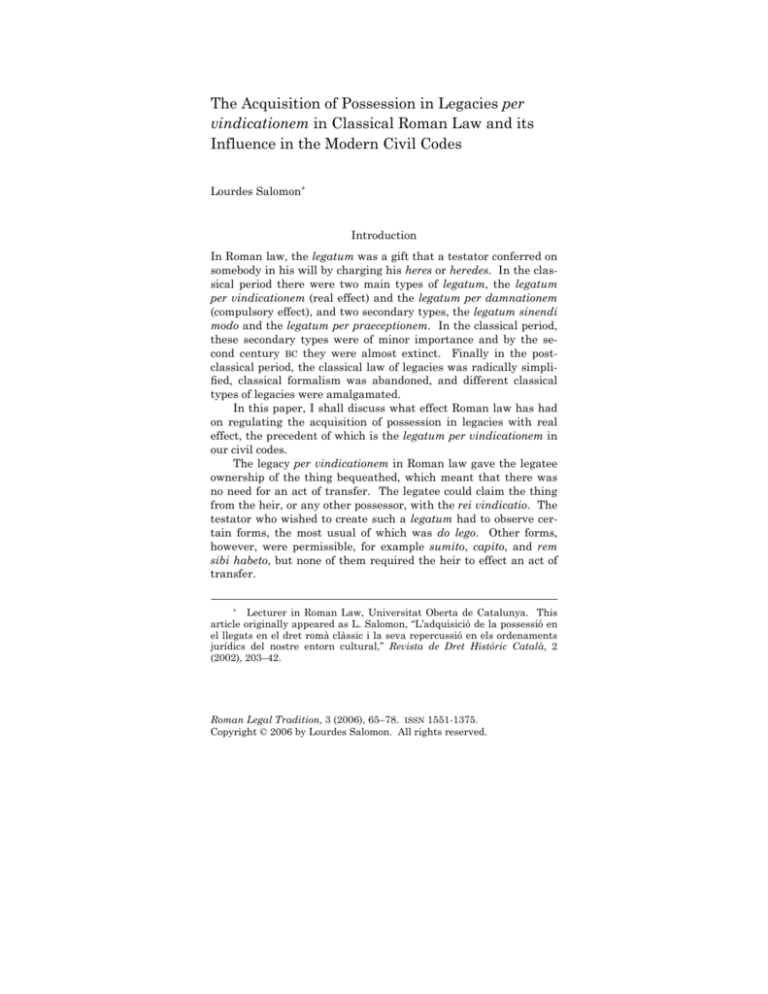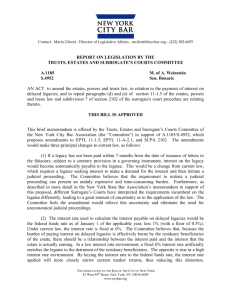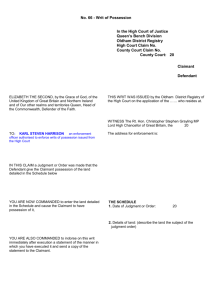
The Acquisition of Possession in Legacies per
vindicationem in Classical Roman Law and its
Influence in the Modern Civil Codes
Lourdes Salomon*
Introduction
In Roman law, the legatum was a gift that a testator conferred on
somebody in his will by charging his heres or heredes. In the classical period there were two main types of legatum, the legatum
per vindicationem (real effect) and the legatum per damnationem
(compulsory effect), and two secondary types, the legatum sinendi
modo and the legatum per praeceptionem. In the classical period,
these secondary types were of minor importance and by the second century BC they were almost extinct. Finally in the postclassical period, the classical law of legacies was radically simplified, classical formalism was abandoned, and different classical
types of legacies were amalgamated.
In this paper, I shall discuss what effect Roman law has had
on regulating the acquisition of possession in legacies with real
effect, the precedent of which is the legatum per vindicationem in
our civil codes.
The legacy per vindicationem in Roman law gave the legatee
ownership of the thing bequeathed, which meant that there was
no need for an act of transfer. The legatee could claim the thing
from the heir, or any other possessor, with the rei vindicatio. The
testator who wished to create such a legatum had to observe certain forms, the most usual of which was do lego. Other forms,
however, were permissible, for example sumito, capito, and rem
sibi habeto, but none of them required the heir to effect an act of
transfer.
*
Lecturer in Roman Law, Universitat Oberta de Catalunya. This
article originally appeared as L. Salomon, “L’adquisició de la possessió en
el llegats en el dret romà clàssic i la seva repercussió en els ordenaments
jurídics del nostre entorn cultural,” Revista de Dret Històric Català, 2
(2002), 203–42.
Roman Legal Tradition, 3 (2006), 65–78. ISSN 1551-1375.
Copyright © 2006 by Lourdes Salomon. All rights reserved.
66
Roman Legal Tradition
Vol. 3
The law of legacies was studied with “unconcealed predilection”1 by classical lawyers, but those who wrote lengthy treatises
neglected the question of the legatee who acquires possession in
legacies with real effect. In previous studies on this subject,2 I
have shown that the proper and usual way to acquire possession
in this kind of legacy was unilateral apprehension by the legatee.
The verbs sumo, capito, and sibi habeo clearly express the act of
seizure that is the right of the legatee.
My thesis also focused on the interdictum quod legatorum.3
This interdict was first introduced by the praetor in the area of
bonorum possessio in the first century BC to protect the bonorum
possessor, and later it was extended to protect the heres from the
legatee who had taken the thing bequeathed without consent:4 ut
quod quis legatorum nomine non ex voluntate heredis occupavit.
This interdict was introduced because of the lex Falcidia, a plebiscite in the year 40 BC, the aim of which was to encourage the heir
charged with legata to accept the inheritance. The lex Falcidia
granted the heir that a quarter of the net inheritance would be
free from legata. In those cases where the legata exceeded threequarters of the net inheritance, the charges were diminished proportionally.5
By studying the semantics of the words used in the formula of
the legacy per vindicationem and analysing the sources of the interdict, I found that the original way for the legatee to acquire
possession was apprehension. After the interdictum quod legatorum had been introduced, however, Roman law did not allow the
legatee to take possession, unilaterally, of the thing bequeathed.
On the contrary, the heir was required to give consent or even
take action. Those modern codes which observe a division between legacies with real and compulsory effect come from this
Roman idea.
This article studies this Roman rule in the main civil codes
that have maintained the legacy with real effect. In particular, I
focus on the Spanish, French, and Italian civil codes, and the
Catalan Code of Succession. The four codes have articles which
have very similar content. They all state that the legatee may not
F. Schulz, Classical Roman Law (Oxford 1951), 314.
L. Salomon, Sine vitio nancisci possessione. La adquisición de la
posesión de los legados en el derecho romano clásico (Madrid 2003).
3
D.43.3 Quod legatorum; C.8.3 Quod legatorum.
4
M. García Garrido, “Notas sobre el interdicto quod legatorum,” in
Estudios Sánchez del Río (Madrid 1967), 227.
5
See Schulz (note 1), 327.
1
2
2006
Legacies per vindicationem
67
take possession of the thing bequeathed on his own authority, but
that he may demand that possession be delivered to the heir.
Article 885 of the Spanish Civil Code states:
El legatario no puede ocupar por su propia autoridad la cosa
legada, sino que debe pedir su entrega y posesión al heredero
o al albacea, cuando éste se halle autorizado para darla.
Article 271.3 of the Catalan Code of Succession act 40/1991 also
states that the legatee may not take the thing bequeathed but
that the heir may deliver it.6
El legatari tindrà acció contra la persona gravada per reclamar el lliurament o cumpliment del llegat exigible, i en el seu
cas, contra la persona facultada per cumplir el llegats.
En el llegat amb efectes reals, quan la propietat de la cosa o
del dret real susceptible de possessió hagi passat al legatari,
aquest tindrà acció per exigir el lliurament de la possessió, i
fins i tot per reinvindicar la cosa o el dret contra quansevol
posseïdor.
Sense el consentiment de la persona gravada o, de la facultada al lliurament, el legatari no podrà prendre possessió, per
la seva pròpia autoritat, de la cosa o drets llegats.
Tanmateix, el legatari podrà prendre per sí mateix la possessió quan el testador ho hagi autoritzat o el llegat sigui
d’usdefruit universal, Així com a Tortosa, si tota l’herència
està distribuïda en llegats.
Although the French code civil uses different terminology, the law
of succession, so far as it concerns the acquisition of possession
from legatees, states in article 1014:
Tous legs pur et simple donnera au légataire, du jour du décès du testateur, un droit à la chose leguée, droit
transmissible à ses héritiers ou ayants cause.
Néanmoins le légataire particulier ne pourra se mettre en
possession de la chose leguée, ni en prétendre les fruits ou
intérêts, qu’à compter du jour de sa demande en délivrance,
6
R. M. Roca Sastre, “La adquisición de la posesión,” Revista General
de Legislación y Jurisprudencia, 193 (1953), 331–87.
68
Roman Legal Tradition
Vol. 3
formé suivant l’ordre établi par l’article 1011, ou du jour auquel cette délivrance lui aurait été volontairement consentie.
Along the same lines, article 649 of the Italian Civil Code states:
Acquisto del legato
Il legato si acquista senza bisogno di accettazione, salva la
facoltà di rinunziare. Quando oggeto del legato e la proprietà
di una cosa determinata o altro diritto appartenente al testatore, la proprietà o il diritto si trasmette dal testatore al legatario al momento della morte del testatore.
Il legatario però deve domandare all’onerato il possesso della
cosa legata, anche quando ne è stato espressamente dispensato dal testatore.
As far as the acquisition of inheritance is concerned, the laws of
succession compared can be divided into two main systems: the
Roman and the German. The Roman system requires acceptance
for inheritance to be acquired whereas the German system allows
acquisition ipso iure. These systems are opposites: the former
does not accept the transmission of possession in succession law,
whereas the latter does. In Roman law, the heir became the
owner of the inherited property once he had accepted the inheritance, but he did not become the possessor. To become the possessor, he had to take the corporeal things belonging to the inheritance under his physical control. The sui were an exception.
They acquired possession automatically on acquiring the inheritance, with no need for acceptance.
The Spanish Civil Code
Article 440 of the Spanish Civil Code deals with the acquisition of
possession by the heir, and states:
La posesión de los bienes hereditarios se entiende transmitida al heredero sin interrupción y desde el momento de la
muerte del causante, en el caso de que llegue a adirse la herencia. El que válidamente repudia una herencia se entiende
que no la ha poseído en ningún momento.
This article, from the code of 24 July 1889, is based on article 554
of the Project of 1851, the nearest predecessor to the Spanish Civil
2006
Legacies per vindicationem
69
Code. This article, in turn, was based on article 7247 of the
French Civil Code, which itself had taken the German idea of possession, the gewere.8 Unlike Roman law, gewere did not require
material apprehension for possession to be acquired. Gewere influenced the French saisine9 and by this route the possessio civilissima reached article 440.10
Once the heir accepts inheritance he is considered to be
possessor of all the things of the inheritance from the moment the
principal dies. This is the result of the so-called posesión civilísima.11 Although the heir by law does not have real possession,
he has the advantages of possession: the possibility of acquiring
the thing by usucapion, the possessory interdicts, and the fruits.
The posesión civilísima makes it possible for the heir to take the
legal effects of possession from his principal. The aim is to
prevent the estate from being without a possessor, which is
something that could go against the interest of those who have
the right of possession (e.g. a creditor or a tenant).
In the first place, Spanish doctrine12 has studied the paradox
of this article as far as the acquisition of possession of legacies is
concerned. The legatee acquires the ownership of the thing bequeathed at the moment that the testator dies,13 but he may not
7
“Les héritiers legitimes et les héritiers naturels sont saisis de
plein droit des biens, droits et actions du défunt sous l’obligation
d’acquitter toutes les charges de la succession.”
8
Paragraphs 1922 and 1942 of BGB establish that possession is
transferred by law with no need for apprehension and that this produces
the same effects as possession obtained through apprehension.
9
J. M. Manresa y Navarro, Comentarios al Código Civil Español,
6:2 (Madrid 1957), 556.
10 G. García Valdecasas, “La adquisición de la herencia en el derecho
español,” Revista de Derecho Privado, no. 323 (1944), 7–123, and “De
nuevo sobre la adquisición de la herencia,” Revista de Derecho Privado, no.
406 (1951), 991–95.
11 M. García Garrido, “De la bonorum possessio a la posesión
civilísima,” Revista de Derecho Notarial, 55 (1967), 115–51, and J. Puig
Brutau, Fundamentos de derecho civil, 3:1 (Barcelona 1989), 77–90.
12 J. L. de los Mozos, “La adquisición de la posesión en los legados,”
Anuario de Derecho Civil, 15:1 (1962), 864–920; M. Albaladejo, Comentarios al código y comulaciones forales, 12:1 (Madrid 1987), 312; J. Puig
Brutau, Fundamentos de de derecho civil, 5:2 (Barcelona 1977), 415; R. M.
Roca Sastre, Derecho hipotecario, 3 (Barcelona 1995), 993 n.3.
13 Article 881 of the Spanish Civil Code states: “El legatario adquiere
derecho a los legados puros y simples desde la muerte del testador y los
transmite a sus herederos.” Article 882.1 states: “Cuando el legado es de
cosa específica y determinada, propia del testador, el legatario adquiere su
70
Roman Legal Tradition
Vol. 3
take it on his own authority. He may only request that the heir
deliver the thing bequeathed, because if he should take the thing
unilaterally, the heir would be dispossessed. If this were to happen, the heir could interdict to recover the thing bequeathed. The
legatee may not take the thing without consent but, should he do
so, possession can be made legal if the heir gives authorization a
posteriori.14 The legatee will have a non-removable possession.
As a legatee, he has a personal action ex testamento and as an
owner he has a rei vindicatio.
In the second place, Spanish doctrine has discussed the
following question: what happens if the legatee already has the
thing in his power at the time of the testator’s death? Albaladejo15 distinguishes between material and immaterial possession. Article 440 means that the heir is a civilissimus possessor:
that is to say, he has immaterial possession of the thing. Therefore, although the legatee already has the thing in his power, he
only has material, not immaterial, possession. Therefore, to obtain full possession, he needs to claim immaterial possession.
Although article 885 requires delivery, the Spanish Civil
Code in the end accepts the possibility that the thing can be taken
by the legatee with the consent of the heir. The doctrine accepts
that the consent of the heir to apprehension is an act that is
equivalent to delivery.16 The main point here, however, is not to
make a formal delivery but to prevent the legatee from taking the
thing on his own authority. To prove that delivery is not essential
in legacies with real effect, the doctrine has argued the possibility
of accepting apprehension when the testator has given his authorization. Some civilists accept that this may be a possibility
because of the dispositive nature of article 440, while others do
not because of the imperative nature of the possessio civilissima.
Jurisprudence accepts that it is possible: the legatee can take the
thing bequeathed when the testator gives authorization. The doctrine agrees, however, that this rule cannot be applied when there
are legal heirs that have not given their consent.
propiedad desde que aquél muere, y hace suyos los frutos o rentas pendientes, pero no las rentas devengadas y no satisfechas antes de la muerte.”
14 M. Albaladejo, Comentarios al código y compilaciones forales, 12
(1987), 326, and F. García Goyena, Concordancias, motivos y comentarios
del código civil español, 2 (Madrid 1973), 140.
15 Albaladejo (note 14), 318.
16 R. M. Roca Sastre, Derecho hipotecario, 2 (Barcelona 1995), 606.
2006
Legacies per vindicationem
71
The aim of this Spanish civil rule, as in Roman law, is to protect the integrity of the inheritance by preventing the possession
of the legatee from going against rights which are specially protected by law: quarta falcidia in Roman law and legal heirs in
Spanish law.
A further question that has been studied by Spanish doctrine
is the nature of this kind of delivery. The delivery of the heir is
not considered to be a tradition in the technical sense: that is to
say, delivery is not a translation of possession with the intention
of transmitting ownership, but simply a translation of possession,
because the legatee was already the owner and the heir was
merely the possessor of a thing that belonged to somebody else.
Nor in Roman law is delivery an essential point in legacies
with real effect. Even in origin, delivery was a foreign element in
this kind of legacy.17
Part of the doctrine states that the ruling of article 885 is
based on the possessio civilissima of the heir.18 Some sources19
speak of the historical conception of the nature of legacy while
others, with whom I agree, refer to interdictum quod legatorum.20
The aim of article 885 of the Spanish Civil Code, as in Roman
law and other codes, is to maintain the integrity of the inheritance, because this is a guarantee for creditors and legal heirs,
who are specially protected by law.
The Catalan Code of Succession
The Roman ruling can also be found in Catalan civil law: the legatee may not take the thing bequeathed on his own authority but
he may request the heir to deliver it.
Catalan law, article 2 of act 40/1991 of 30 December, states
that succession comes into effect upon the death of the principal,
and article 5 adds that the heir can acquire a thing bequeathed
only with acceptance. The Catalan Code of Succession faithfully
follows the Roman system. For this reason, although the heir
may acquire the estate and rights of the principal, he does not
have possession of the estate. Article 6 states that the accepting
17 J. B. Vallet de Goytisolo, Estudios de derecho sucesorio, 1 (Madrid
1980), 447–48.
18 Albaladejo (note 14), 328.
19 A. Calvo Meijide, La posesión en el derecho hereditario (Madrid
1997), 112.
20 De los Mozos (note 12), 871–75, and R. M. Roca Sastre, Derecho
hipotecario, 6 (Barcelona 1997), 93 n.21.
72
Roman Legal Tradition
Vol. 3
heir only has material and real possession.21 This is not a new
development in the Catalan law of succession, but it is a feature
which has a long Roman tradition. Classical Roman law required
apprehension to acquire the possession of an inheritance. The
figure of the principal first appeared in article 222-2 of the project
to compile a special Catalan law in 1955. The acceptance of an
inheritance transfers the rights of the principal and the ius possidendi, that is, the right to possess, to the heir, but it does not
transfer the real possession of things. Acceptance legitimizes the
heir to take possession of the inheritance but, as in Roman law, he
needs to take possession of both the animus and the corpus. This
can be done by occupancy, delivery, or recovery of possession. In
accordance with what is stipulated in article 5 and 6, the effects of
acceptance and possession are carried back to the time of death of
the principal.
As far as legacies with real effect are concerned, article 267
states that there is no need for acceptance in order for the legatee
to acquire full rights to the ownership of the thing that is the object of the legacy, but that he does not acquire possession. Like
the heir, the legatee does not acquire possession without really
and materially taking the thing. Article 271 stipulates that the
legatee may not take possession on his own authority without the
consent of the encumbered person. The legatee may proceed
against the person encumbered with an action to request delivery.
However, the third paragraph of article 271 reads:
. . . sense el consentiment de la persona gravada o, de la facultada al lliurament, el legatari no podrà prendre possessió,
per la seva pròpia autoritat, de la cosa o drets llegats.
Thus, sensu contrario, it accepts that one way of acquiring possession in legacies with real effect is, as in Roman law, to apprehend
the thing bequeathed with the consent of the heir. The heir must
give his consent because legacy may be reduced by certain circumstances (quarta falcidia). This rule serves as a guarantee to
the heir who may count on the assets of the inheritance to pay
creditors (article 36 CS), to verify the effectiveness of legacies (articles 373 ff. CS) and to protect the quarta falcidia (article 274.1
CS).
21
l’hereu.
1994).
E. Torrelles i Torrea, La possessió civilíssima i la possessió de
Sistema d’adquisició de la possessió mortis causa (Barcelona
2006
Legacies per vindicationem
73
The last paragraph of this article contains three more exceptions to this rule which accept that the legatee may take for himself the thing bequeathed. The first of these exceptions is when
authorization has been given by the testator; the second is when
the legacy is universal or general usufruct; and the third, only in
Tortosa, is if the entire inheritance is distributed into legacies.
The first exception is not provided for, as we have already seen, in
the Spanish Civil Code and it is expressly denied in the Italian
Civil Code. The doctrine22 states that even though the testator
may give the authorization, the consent of the legal heirs is required because their right is preferential to the right of the legatees. The third exception23 also requires that the legal heirs give
their consent.
In this respect, as in others of the law of succession, the law
of Catalonia embodies the great principles inherent in Roman law
to a greater extent than the other civil laws in our legal tradition
do. In the Catalan code, the Roman system of acquisition of possession in legacies with real effect — apprehension with consent
— remains in force.
The Italian Civil Code
The Italian Civil Code of 1865 was based on the law of succession
in the Napoleonic code. The current Italian code, however, has
returned to the so-called Roman system and so requires the acceptance of inheritance.
Article 459 of the Italian Civil Code establishes that inheritance is acquired by the acceptance as heir. The acceptance comes
into effect as from the opening of the succession.
Aqcuisto dell’eredità
L’eredità si acquista con l’accetazione. L’effeto dell’accettazzione rissale al momento nel quale si è apperta la successione.
Article 460 states:
22 P. Albiol Marés, Comentarios al código de sucesiones de Catalunya,
2 (Barcelona 1994), 965.
23 E. Vendrell Ferrer, “Lliurament i possessio de llegats. Comentari
a la sentència número 1/1990, de 25 de gener de la Sala Civil del TSJ de
Catalunya,” Revista Jurídica de Catalunya, 3 (1990), 799.
74
Roman Legal Tradition
Vol. 3
Poteri del chiamato prima dell’accetazione. Il chaimato
all’eredità può esercitare le azioni possessorie a tutela dei
beni ereditari senza bisogno di materiale apprensione.
Egli inoltre può compiere atti conservativi, di vigilanza e di
ammonostrazione temporanea, e può farsi autorizzare
dall’autorità giudiziaria a vendere i beni che non si possono
conservare la cui conservazione importa grave dispendio.
Non può il chiamato compiere gli atti indicati nei commi precedente, quando si è proveduto alla nomina di un curatote
dell’eredità a norma dell’articolo 528.
In accordance with what is stated in article 1146, from the moment of the succession, possession is with the heir. Article 460
gives the person summoned the appearance of a possessor but not
real possession. The aim of this article is to prevent the settlement of possession from harming the interests of the heir. The
fact that it is legitimate for the person summoned to the inheritance to undertake possessory actions does not mean that a succession of possession has taken place, even fictitiously. The person summoned has possessory interdicts but has neither
possession nor detention.
The legacy is acquired without acceptance and the effects of
the legacy are independent of the heir’s acceptance. In the Italian
Civil Code, the legacy and the testamentary succession are almost
totally independent from each other.
Paragraph 3 of article 649 states that the legatee must claim
possession of the legated thing from the heir even when the legatee has been authorized by the testator to take the thing by himself. Possession is the only relation between the inheritance and
the legacy because the person summoned has the appearance of
possession so that he can maintain the estate as a guarantee of
his title. For this reason the period of usucapio for the heir begins
at the moment of succession: the heir appears to have possession
while the legatee may ask the heir for possession.
Although ownership is transmitted directly from the de cuius
to the legatee, possession is transmitted not to the legatee but to
the heir. The legatee need not ask the heir for possession formally but, as in other civil codes, the Italian code ends by accepting that the legatee can take the thing by himself with the consent of the heir. If the legatee already has possession by virtue of
another title, he may ask the heir for possession because he has
real possession, while the heir has the appearance of a possessor:
2006
Legacies per vindicationem
75
nemo sibi causam possessionem mutare potest (nobody can unilaterally change the cause of the possession).
Doctrine has debated the reason for this. Some believe that
this rule is based on the fact that the person summoned acquires
the appearance of the possessor of the inheritance. Others, however, consider that the heir is interested in keeping the inheritance available before the effectiveness of the legacy is known. It
has also been suggested that this rule shows the compulsory nature of the legacy with real effect.24
But possession can also be requested from another person
who is encumbered or entitled to deliver. This shows that the rule
cannot be explained by the fact that the inheritance is in possession of the heir but, as in Roman law, by the need to keep the inheritance whole. Again the most plausible explanation of this
rule is based on the consequences of the legacy with real effect:
the encumbered person must be able to keep possession until the
efficacy of the legacy has been checked.
The French Civil Code
The French law of succession belongs to the German family. The
sentence “le mort saisit le vif” means that, at the moment the
principal dies, the heirs acquire all of his estate and rights so
there is no interruption. Therefore, unlike the Roman system, the
inheritance always has an owner. The Napoleonic code adopted
its own customary system (common law) and not the Roman and
feudal system. The French law of succession is a familiar law.
The aim of the will is not to institute an heir but to establish patrimonial distributions, that is, universal legacies, with universal
or specific title.
Article 1004 states:
Lorsqu’au décès du testateur, il y a des héritiers auxquels une
quotité de ses biens est réservée par la loi, ces héritiers sont
saisis de plein droit, par sa mort, des tous les biens de la succession, et le légataire universel est tenu de leur demander la
délivrance des biens compris dans le testament.
This continuity is to prevent power from being interrupted. For
this reason, the Code recognizes that some heirs can act as pos24 See A. Masi, Dei legati: art. 649–673 (Bologna 1979); L. Gangi, La
successione testamentaria (Milan 1947); F. S. Azzariti, G. Martinez, and G.
Azzariti, Successioni per causa di morte (Padua 1979).
76
Roman Legal Tradition
Vol. 3
sessors of the inheritance without needing to ask a judge for the
mise en posséssion, as the other irregular successors without
saisine have to do. Saisine is reserved for the unquestioned successors, who can take things by themselves, and carries all the
effects of possession: execution of the actions, usucapio, and acquisition of the fruits.
Article 724 establishes saisine for the legal heirs whose title
is unquestionable. Of the testamentary heirs, only the universal
legatee has saisine (article 1006) because he has full inheritance
rights and can therefore take things by himself with no formalities. Legatees with universal or specific titles can ask the intestate heirs for possession.
Saisine is a simple faculty for apprehending the inheritance
and executing the right to prevent the loss of the inheritance. It
is not related to ownership: legatees with universal or specific
titles are owners of the thing bequeathed but they do not have
possession, because the faculty of taking possession is not the
same as the real taking of possession. Saisine enables the heirs
without authorization to take and administer the inheritance, to
carry out juridical acts, and to perceive the fruits. Saisi heirs,
however, do not have the estate at their disposal.
The delivery of the bequest depends on the saisi heir verifying
the title. When there is more than one legatee, they may all ask
for their portions but there are no formalities connected to this
request and to delivery. The delivery can be an express or tacit
act. As in other legal systems, tacit consent can be understood to
be the voluntary execution of the legacy.
French tribunals25 have also accepted tacit delivery. When
legatees take the bequest with the authorization of the heirs or
are in possession with their consent, jurisprudence considers this
act equivalent to delivery.26 Should the heirs not wish to deliver
the bequest to the legatees, the legatees have an action of delivery. This delivery does not transmit ownership because the legatee is already the owner and delivery does not preclude a possible
action of reduction.
Conclusions
To sum up, I would like to emphasize the force in our legal system
of a Roman rule that is not very well known: the legatee may take
25
26
Cass. 1e civ., Feb. 17, 1971, D. 1971, Somm. 141.
Cass. 1e civ., Nov. 18, 1968, D. 1969, J.C.P. [II] 15973.
2006
Legacies per vindicationem
77
a bequest on his own authority when he has the consent of the
heir. All of the four codes studied here contain an article with
very similar wording, stating that the legatee may not take a bequest but that the bequest can be delivered by the heir. However,
as we have seen, both jurisprudence and doctrine accept that the
legatee taking the bequest with the consent of the heir is equivalent to delivery. The act, performed this way, is in accordance
with the law.
My thesis is that, in the domain of legacies with real effect,
apprehension with consent is not equivalent to delivery but is the
original way of obtaining possession. Originally in Roman law,
the words used in the formula clearly expressed this act of apprehension and today these legacies prevail because our codes accept
them even though in principle they do not. In the ius civile, the
legacy with real effect was able to transfer a thing recta via from a
deceased person to a legatee, with no intervention from the heir.
Therefore, in this kind of legacy, unilateral apprehension by the
legatee was the way to acquire possession. Unilateral apprehension was also the typical way of acquiring possession in relationships mortis causa. For example, there were originally two acts
by which the heredes extranei could accept inheritance, cretio and
pro herede gestio, both of which had an evident possessory structure and always consisted of an act of apprehension by the heir.
So, I understand that, in the inter vivos relationships, apprehension with consent can be an act that is equivalent to tradition, as
classical Roman jurisprudence has already admitted in cases of
extended modes of tradition. In the legacies with real effect, however, apprehension with consent cannot be considered to be
equivalent to tradition. In my opinion, and because of the wording of the legislator in the articles studied, both doctrine and jurisprudence have made a long and unnecessary journey and used a
seemingly solid but mistaken argument to accept a fact that is
inherent in legacies with real effect: apprehension by the legatee
with consent.
The origin of all the articles studied from the various codes is
the classical Roman interdict quod legatorum. They all have the
same aim: to preserve the integrity of the inheritance as a guarantee of an interest that the legal system wants to protect. In
Roman law, the aim was to protect the heir and to encourage testate succession and thus prevent property from remaining intestate; the aim of our current systems is to protect the rights of the
legal heirs and the creditors of the principal.
78
Roman Legal Tradition
Vol. 3
This study shows that the origin and nature of an institution
needs to be known if the current reality of our institutions is to be
understood.
——————————————








